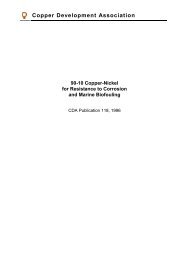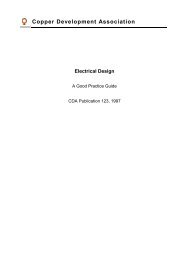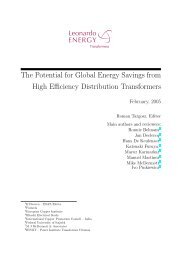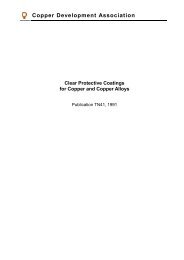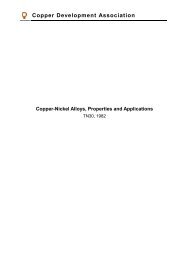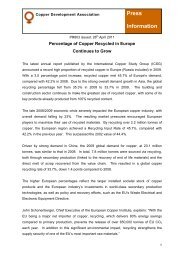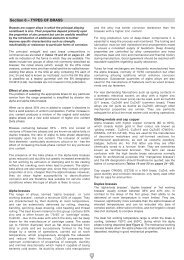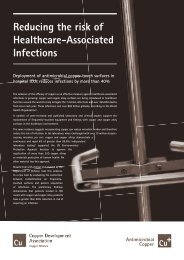4.5.1 Resilient Power Supply in a Modern Office Building - Copper ...
4.5.1 Resilient Power Supply in a Modern Office Building - Copper ...
4.5.1 Resilient Power Supply in a Modern Office Building - Copper ...
Create successful ePaper yourself
Turn your PDF publications into a flip-book with our unique Google optimized e-Paper software.
<strong>Power</strong> Quality Application GuideResilience<strong>Resilient</strong> <strong>Power</strong> <strong>Supply</strong> <strong>in</strong> a<strong>Modern</strong> <strong>Office</strong> Build<strong>in</strong>g<strong>4.5.1</strong><strong>Copper</strong> Development AssociationIEE Endorsed ProviderResilience
Resilience<strong>Resilient</strong> <strong>Power</strong> <strong>Supply</strong> <strong>in</strong> a <strong>Modern</strong> <strong>Office</strong> Build<strong>in</strong>gHans De Keulenaer, European <strong>Copper</strong> InstituteProf Angelo Bagg<strong>in</strong>i, Università di BergamoJune 2003This Guide has been produced as part of the Leonardo <strong>Power</strong> Quality Initiative (LPQI), aEuropean education and tra<strong>in</strong><strong>in</strong>g programme supported by the European Commission(under the Leonardo da V<strong>in</strong>ci Programme) and International <strong>Copper</strong> Association. For further <strong>in</strong>formationon LPQI visit www.lpqi.org.<strong>Copper</strong> Development Association (CDA)<strong>Copper</strong> Development Association is a non-trad<strong>in</strong>g organisation sponsored by the copper producersand fabricators to encourage the use of copper and copper alloys and to promote their correctand efficient application. Its services, which <strong>in</strong>clude the provision of technical advice and <strong>in</strong>formation, areavailable to those <strong>in</strong>terested <strong>in</strong> the utilisation of copper <strong>in</strong> all its aspects. The Association also provides al<strong>in</strong>k between research and the user <strong>in</strong>dustries and ma<strong>in</strong>ta<strong>in</strong>s close contact with the other copper developmentorganisations throughout the world.CDA is an IEE endorsed provider of sem<strong>in</strong>ar tra<strong>in</strong><strong>in</strong>g and learn<strong>in</strong>g resources.European <strong>Copper</strong> Institute (ECI)The European <strong>Copper</strong> Institute is a jo<strong>in</strong>t venture between ICA (International<strong>Copper</strong> Association) and IWCC (International Wrought <strong>Copper</strong> Council) contribut<strong>in</strong>gmembers. Through its membership, ECI acts on behalf of the world’slargest copper producers and Europe’s lead<strong>in</strong>g fabricators <strong>in</strong> promot<strong>in</strong>g copper <strong>in</strong> Europe. Formed <strong>in</strong>January 1996, ECI is supported by a network of ten <strong>Copper</strong> Development Associations (‘CDAs’) <strong>in</strong> Benelux,France, Germany, Greece, Hungary, Italy, Poland, Scand<strong>in</strong>avia, Spa<strong>in</strong> and the UK. It furthers the efforts <strong>in</strong>itiallyundertaken by the <strong>Copper</strong> Products Development Association, formed <strong>in</strong> 1959, and INCRA(International <strong>Copper</strong> Research Association) formed <strong>in</strong> 1961.DisclaimerThe content of this project does not necessarily reflect the position of the European Community, nor doesit <strong>in</strong>volve any responsibility on the part of the European Community.European <strong>Copper</strong> Institute, Università di Bergamo and <strong>Copper</strong> Development Association disclaim liabilityfor any direct, <strong>in</strong>direct, consequential or <strong>in</strong>cidental damages that may result from the use of the <strong>in</strong>formation,or from the <strong>in</strong>ability to use the <strong>in</strong>formation or data conta<strong>in</strong>ed with<strong>in</strong> this publication.Copyright© European <strong>Copper</strong> Institute, Università di Bergamo and <strong>Copper</strong> Development Association.Reproduction is authorised provid<strong>in</strong>g the material is unabridged and the source is acknowledged.LPQI is promoted <strong>in</strong> the UK by members of the <strong>Power</strong> Quality Partnership:®Fluke (UK) LtdRhopo<strong>in</strong>t Systems LtdMGE UPS Systems Ltd
Resilience<strong>Resilient</strong> <strong>Power</strong> <strong>Supply</strong> <strong>in</strong> a <strong>Modern</strong> <strong>Office</strong> Build<strong>in</strong>gIntroductionThis application note presents a design approach to assure a resilient and reliable power supply <strong>in</strong> anelectronics-<strong>in</strong>tensive modern office build<strong>in</strong>g. It describes a case study of a 10-floor office build<strong>in</strong>g <strong>in</strong> Milan,Italy (hereafter referred to as ‘the build<strong>in</strong>g’ for confidentiality reasons). The build<strong>in</strong>g is the head office of amajor f<strong>in</strong>ancial <strong>in</strong>stitution and is occupied by 500 employees us<strong>in</strong>g <strong>in</strong>formation technology equipment<strong>in</strong>tensively.Follow<strong>in</strong>g an assessment of the current status of the electrical <strong>in</strong>stallation <strong>in</strong> the build<strong>in</strong>g, accompanied bythe results of power quality measurements, two design proposals are presented that assure a resilient andreliable power supply. A cost analysis completes this report.Description of <strong>in</strong>itial situationDistribution schemeThe build<strong>in</strong>g is connected to a 23 kVgrid. The medium voltage ma<strong>in</strong> powersupply consists of two 800 kVAtransformers, 23/0.4 kV, 50 Hz. The lowvoltage side of the <strong>in</strong>stallation isdesigned as a TN-S system.The load is subdivided <strong>in</strong>to standard,preferential, and privileged loads,accord<strong>in</strong>g to requirements forcont<strong>in</strong>uity of supply (this is discussed <strong>in</strong>greater detail later <strong>in</strong> the section). Thereis a second po<strong>in</strong>t of common coupl<strong>in</strong>g(PCC) to feed a small portion of thestandard load. The two PCCs are fedfrom the same grid po<strong>in</strong>t and so are not<strong>in</strong>dependent.To assure cont<strong>in</strong>uity of the powersupply, two UPSs (80 + 200 kVA) and amotor generator (250 kVA) are <strong>in</strong>stalledaccord<strong>in</strong>g to the scheme <strong>in</strong> Figure 1.Note that <strong>in</strong> such a scheme it isimperative that the neutral conductor isconnected to earth only once, at thema<strong>in</strong> earth<strong>in</strong>g term<strong>in</strong>al, and not at eachtransformer. Otherwise, the benefits ofthe TN-S wir<strong>in</strong>g configuration –improved EMC and power quality - arelost.GSD250 kVAMV 23 kVThe primary distribution is acompromise between radial and shunt schemes 1 . The <strong>in</strong>stallation has grown <strong>in</strong> a haphazard way, withouta consistent structure. This is a direct result of the many changes <strong>in</strong> power requirements experienced dur<strong>in</strong>gDGSTR1800 kVA200 kVATR2800 kVA400 V LVLV400 VStandardLoadsGeneratorMotorUPSPrivilegedLoadsStandard <strong>Supply</strong>PrivilegedLoads1Shunt scheme: a ris<strong>in</strong>g busbar or power l<strong>in</strong>e is shared for all floors; at each floor, a connection is made to the LV panel atthe floor. Radial scheme: each LV panel at each floor has a dedicated connection with its correspond<strong>in</strong>g switchgear at thema<strong>in</strong> LV distribution panel <strong>in</strong> the basement.80 kVALV400 VFigure 1 – Present distribution schemeStandard <strong>Supply</strong>StandardLoads1
<strong>Resilient</strong> <strong>Power</strong> <strong>Supply</strong> <strong>in</strong> a <strong>Modern</strong> <strong>Office</strong> Build<strong>in</strong>gDescription of standard load Type of power supply required Tim<strong>in</strong>g needed for <strong>in</strong>terventionAllows regular function<strong>in</strong>g of the build<strong>in</strong>g,but their unavailability does not result <strong>in</strong>risk to personnel or equipment:General services, e.g. air condition<strong>in</strong>g(but not <strong>in</strong> server room)Normal light<strong>in</strong>gHeat<strong>in</strong>g<strong>Power</strong> socketsStandard radial circuitsResumption of service can wait forsome time without damageLoads can be switched offNoneUnavailability of service forrelatively long time periods can betoleratedTable 1 - Description, criteria, design, and <strong>in</strong>tervention requirements for standard loadsDescription of preferential load Type of power supply required Tim<strong>in</strong>g needed for <strong>in</strong>terventionRegular function<strong>in</strong>g of the load is requiredfor comfort and security of personnel andclients, as well as for ensur<strong>in</strong>g smoothbus<strong>in</strong>ess operation. For example:Light<strong>in</strong>g of staircases, corridors, andcerta<strong>in</strong> roomsM<strong>in</strong>imum light<strong>in</strong>g conditions to avoidpanicHeat<strong>in</strong>g or air condition<strong>in</strong>g of certa<strong>in</strong>roomsElevatorsUPSBackupDual radial primary supply,ensur<strong>in</strong>g the functional andphysical <strong>in</strong>dependence of the risersTwo separate risers can beemployed, supported either by agenerator or supplied from two<strong>in</strong>dependent grid po<strong>in</strong>tsSwitch<strong>in</strong>g off the load is notacceptableAccord<strong>in</strong>g to the norm, a 20second <strong>in</strong>tervention time for thegenerator group is acceptable forlong <strong>in</strong>terruptions. Typical valuesfor a diesel group:First attempt with<strong>in</strong>5 secondsSecond attempt with<strong>in</strong>10 secondsThird attempt with<strong>in</strong>15 secondsTable 2 - Description, criteria, design, and <strong>in</strong>tervention requirements for preferential loadsDescription of privileged load Type of power supply required Tim<strong>in</strong>g needed for <strong>in</strong>terventionEssential services:SecureLoads with <strong>in</strong>tervention with<strong>in</strong> 15secondsSecurity light<strong>in</strong>gServersTelecommunication systemsPersonnel retrievalAlarm & security systemsFire signall<strong>in</strong>g and anti-fire systemsClosed-loop TV circuitsCerta<strong>in</strong> auxiliary servicesDual radial scheme, with<strong>in</strong>dependent risersAt least one riser has to ensure highgrid reliabilityUse of UPSFor certa<strong>in</strong> loads, a dedicated UPScan be consideredShort-<strong>in</strong>terruption loads, with<strong>in</strong>0.15 secondsSome loads need cont<strong>in</strong>uoussupplyTable 3 - Description, criteria, design, and <strong>in</strong>tervention requirements for privileged loads5
<strong>Resilient</strong> <strong>Power</strong> <strong>Supply</strong> <strong>in</strong> a <strong>Modern</strong> <strong>Office</strong> Build<strong>in</strong>gPrivileged loads are mission-critical. Loss of servicemeans grave danger to personnel or severe damage tothe organisation’s bus<strong>in</strong>ess processes. The level of<strong>in</strong>dependence needs to be determ<strong>in</strong>ed for each load.At the very least, these loads must be supplied fromtwo <strong>in</strong>dependent feeders with automatic switch<strong>in</strong>g(Table 3).Type of loadPercentageStandard 49%Preferential 13%Privileged 38%Table 4 - Classification of type of loadsMa<strong>in</strong> distribution schemesTo avoid the exist<strong>in</strong>g bottleneck at LV ma<strong>in</strong> busbar, the primary distribution must be modified as a dualradial distribution (Figure 7 left).Standard <strong>Supply</strong>MV23 kVMV23 kV2K (1/2+1/8) A500 kVADGS2 (A K)TR1100 kVA2 (A K)TR2800 kVADGS2K(1/2+1/8) A500 kVATR3800 kVALVLV400 V400 VK 3/8 A150 kVAUPSK 1/2 A200 kVAK 1/8 A50 kVAK 1/8 A50 kVAUPSK 1/2 A200 kVAK 3/8 A150 kVA800 kVAStandardLoadsPrivilegedLoadsPreferentialLoadsPreferentialLoadsPrivilegedLoadsStandardLoadsHVACGSGeneratorDMotorUPSFigure 7 – New ma<strong>in</strong> distribution schemeThe rat<strong>in</strong>g of the transformers TR1 and TR2 must ensure that each can carry the full load. Consider<strong>in</strong>g that,because of the nature of the loads, the load current waveform will be highly distorted, the transformersmust be sized to take account of the harmonic content. Rat<strong>in</strong>g transformers to cope with harmoniccurrents is discussed <strong>in</strong> Section 3.5.2.To reduce short circuit currents, the system is normally managed with the ma<strong>in</strong> busbar-breaker open, butparallel operation between the two ma<strong>in</strong> transformers is possible for a short time.To feed the thermal and HVAC services, the transformer section must be modified as shown <strong>in</strong> Figure 7 witha new 800 kVA transformer, TR3, <strong>in</strong> addition to the exist<strong>in</strong>g two.Standard loads are supplied from a s<strong>in</strong>gle grid po<strong>in</strong>t. The same grid power cable, riser, and radialdistribution also supplies preferential and privileged loads.Two generator groups supply preferential and privileged loads. Standard loads are switched off through thebreakers at the extremity of the ma<strong>in</strong> busbar.6
<strong>Resilient</strong> <strong>Power</strong> <strong>Supply</strong> <strong>in</strong> a <strong>Modern</strong> <strong>Office</strong> Build<strong>in</strong>gUtilisation & <strong>Power</strong> requirementInstalled load (kVA)Installed power (kVA)Contemporary Factors(kVA)Load<strong>Power</strong> Light <strong>Power</strong> Light <strong>Power</strong> Light <strong>Power</strong> Light(1) (2) (3) (4) (5) (6) (7) (8)Second underground 7 10 0.7 1 5 10 6.5 11.5First underground 114 15 0.7 1 80 15 104 17.25Ground and general services 43 15 0.7 1 30 15 39 17.25First floor 50 17 0.7 1 35 17 45.5 19.55Second floor 50 17 0.7 1 35 17 45.5 19.55Third floor 50 17 0.7 1 35 17 45.5 19.55Fourth floor 50 17 0.7 1 35 17 45.5 19.55Fifth floor 50 17 0.7 1 35 17 45.5 19.55Sixth floor 50 17 0.7 1 35 17 45.5 19.55Seventh floor 50 17 0.7 1 35 17 45.5 19.55Eighth floor 29 12 0.7 1 20 12 26 13.8N<strong>in</strong>th floor 3 2 0.7 1 2 2 2.6 2.3Thermal Central 29 0 0.7 -- 20 0 26 0HVAC ma<strong>in</strong> station 843 0 0.7 -- 590 0 767 0Boxes 14 5 0.7 1 10 5 13 5.75Elevators 114 0 0.7 1 80 0 104 0TOTAL 1546 178 -- -- 1082 178 1407 204.7Table 5 - Peak-rated and actual siz<strong>in</strong>g of primary distribution systemConsider<strong>in</strong>g the measured waveform of the current, all the new l<strong>in</strong>es have been sized to take <strong>in</strong>to accountthe harmonic profile and resilience requirements: neutral cross-section equal to that of phase (Section 3.5.1) derated cables (Section 3.1 and 3.5.1).Special attention should be paid to neutral and phase conductor siz<strong>in</strong>g to avoid overheat<strong>in</strong>g and faultytripp<strong>in</strong>g of protection devices. The adoption of a UPS or motor generator is not useful if a l<strong>in</strong>e fault occursafter it.Cost analysisThe cost of the exist<strong>in</strong>g <strong>in</strong>stallation is compared with two possible alternative solutions <strong>in</strong> Table 6. Thesealternatives differ only for risers, and hence for the cost of the ma<strong>in</strong> LV panel.Solution 1 is the shunt scheme, and Solution 2 is the simple radial scheme, which is preferable for newbuild<strong>in</strong>gs, but difficult to implement as an <strong>in</strong>stallation upgrade.Cost when selected at <strong>in</strong>itial design stageRegard<strong>in</strong>g this situation, the follow<strong>in</strong>g needs to be highlighted: the percentages refer to the cost of the exist<strong>in</strong>g <strong>in</strong>stallation the extra cost of the better solutions is low, if considered at the <strong>in</strong>itial design stage the cost of the best technical solution (i.e. Solution 2 – s<strong>in</strong>gle radial scheme at f<strong>in</strong>al distribution)differs only by 3% from Solution 1 if considered at <strong>in</strong>itial design stage, but the difference is muchgreater if considered at refurbishment stage only cost basis 2001the cost for the UPS considers only purchase and <strong>in</strong>stallation. The additional costs of ma<strong>in</strong>tenancemust be taken <strong>in</strong>to account.8
<strong>Resilient</strong> <strong>Power</strong> <strong>Supply</strong> <strong>in</strong> a <strong>Modern</strong> <strong>Office</strong> Build<strong>in</strong>gEven if the evaluation of average costs related to a system designed accord<strong>in</strong>g to good PQ practice isdifficult, it must be recognised that:the cost estimates <strong>in</strong>clude the costs related to the practical difficulties of <strong>in</strong>stall<strong>in</strong>g and renew<strong>in</strong>g abuild<strong>in</strong>g <strong>in</strong> the centre of a major citythe modification of the ma<strong>in</strong> distribution scheme is the most important and useful action toundertakethe solution with unique riser l<strong>in</strong>es is very difficult to <strong>in</strong>stall with the build<strong>in</strong>g operational.ItemCost at design stageExist<strong>in</strong>g(€)Solution 1(€)Solution 2(€)Ma<strong>in</strong> LV panel 32 000 35 000 45 000Risers 30 000 35 000 60 000Horizontal distribution 107 000 135 000 135 000Generator groups 87 000 107 000 107 000UPS 55 000 105 000 105 000Motive power 355 000 375 000 375 000Light<strong>in</strong>g 500 000 525 000 525 000Total 1 166 000 1 317 000 1 352 000Differential cost 151k (+13%) 186k (+16%)Cost for <strong>in</strong>stallation upgradeAdditional cost 422k (+36%) 543k (+46%)Table 6 - Cost ComparisonConclusionInitial low cost does not necessarily mean good value. A PQ compliant system, <strong>in</strong>itially more expensive, cansave a great deal of money dur<strong>in</strong>g its life. The case study analysed <strong>in</strong> this paper shows that an electrical<strong>in</strong>stallation, designed without attention to PQ issues, results <strong>in</strong> a considerable amount of unnecessaryexpenditure. Decisions have to be made whether to resolve the issues or to simply live with the<strong>in</strong>convenience and downtime they cause.The cost/benefit analysis shows that resilience should be carefully considered at the design stage. A mere<strong>in</strong>crease of 16% <strong>in</strong> the <strong>in</strong>stallation cost (1% of the build<strong>in</strong>g cost) provides:three l<strong>in</strong>es of defence aga<strong>in</strong>st power cuts for mission-critical loads (dual panels at each floor,generator, UPS)a highly resilient system, with each floor supplied by two distribution panels. Each panel is<strong>in</strong>dependent from the other, and from all panels on the other floorsa highly flexible electrical system aga<strong>in</strong>st future load growth.Expensive though it may seem, the highly resilient solution would typically add only about 1% to the costof the build<strong>in</strong>g. For commercial build<strong>in</strong>gs, where the runn<strong>in</strong>g costs amount to <strong>in</strong>itial construction costsafter 7-8 years, this <strong>in</strong>itial <strong>in</strong>vestment will be paid back by a productivity <strong>in</strong>crease of 10 m<strong>in</strong>utes per week.All the rest is profit.A design accord<strong>in</strong>g to present standards does not guarantee optimum performance from power quality andEMC viewpo<strong>in</strong>ts and enhanced solutions have to be considered. At European level, better standards are atpresent under preparation.9
<strong>Resilient</strong> <strong>Power</strong> <strong>Supply</strong> <strong>in</strong> a <strong>Modern</strong> <strong>Office</strong> Build<strong>in</strong>gReferences1. P Chizzol<strong>in</strong>i, P L Noferi: Ottimizzazione degli <strong>in</strong>terventi sulla rete di distribuzione mirati al miglioramento dellacont<strong>in</strong>uita’ del servizio elettrico. LXXXVII Riunione AEI, Firenze 1986.2. T M Gruzs: ‘A survey of neutral currents <strong>in</strong> three-phase computer power systems’, IEEE Transaction on <strong>in</strong>dustryapplications, vol. 26, n° 4 July/August 1990.3. IEC 364-5-523 - Electrical <strong>in</strong>stallations of build<strong>in</strong>gs - Part 5-52: Selection and erection of electrical equipment - Wir<strong>in</strong>gsystems.4. A Bagg<strong>in</strong>i, A Bossi, ‘Componenti e carichi suscettibili ai disturbi’, Corso ‘Interazioni elettromagnetiche tra componentie sistemi <strong>in</strong> ambito <strong>in</strong>dustriale: compatibilità elettromagnetica <strong>in</strong> bassa frequenza’ Dipartimento di Elettrotecnica delPolitecnico di Milano, 21-25 febbraio 1994.5. A Silvestri, F Tommazzolli, ‘Schemi per gli impianti di energia: semplicità, affidabilità, risparmio, ridondanza dove ecome’, Corso ‘Il progetto degli impianti elettrici di energia. Le norme e la regola dell’arte’, Dipartimento di IngegneriaElettrica dell’Università degli Studi di Pavia, AEI, CNR, Pavia, 10-13 giugno 1991.10
Notes12
Reference & Found<strong>in</strong>g PartnersEuropean <strong>Copper</strong> Institute(ECI)Web: www.eurocopper.orgAkademia Gorniczo-Hutnicza(AGH)Web: www.agh.edu.plCentre d'Innovació Tecnològica enConvertidors Estàtics i Accionaments(CITCEA)Web: www-citcea.upc.esComitato Elettrotecnico Italiano(CEI)Web: www.ceiuni.it<strong>Copper</strong> BeneluxWeb: www.copperbenelux.org<strong>Copper</strong> Development Association(CDA UK)Web: www.cda.org.ukDeutsches Kupfer<strong>in</strong>stitut(DKI)Web: www.kupfer<strong>in</strong>stitut.deEng<strong>in</strong>eer<strong>in</strong>g Consult<strong>in</strong>g & Design(ECD)Web: www.ecd.itHochschule für Technik und Wirtschaft(HTW)Web: www.htw-saarland.deIstituto Italiano del Rame(IIR)Web: www.iir.itInternational Union of Electrotechnology(UIE)Web: www.uie.orgISR - Universidade de CoimbraWeb: www.uc.ptKatholieke Universiteit Leuven(KU Leuven)Web: www.kuleuven.ac.beLa Escuela Técnica Superior deIngenieros Industriales (ETSII)Web: www.etsii.upm.esPolish <strong>Copper</strong> Promotion Centre(PCPC)Web: www.miedz.org.plProv<strong>in</strong>ciale Industriele Hogeschool(PIH)Web: www.pih.beUniversità di BergamoWeb: www.unibg.itUniversity of BathWeb: www.bath.ac.ukUniversity of Manchester Institute ofScience and Technology (UMIST)Web: www.umist.ac.ukWroclaw University of TechnologyWeb: www.pwr.wroc.plEditorial BoardDavid Chapman (Chief Editor) CDA UK david.chapman@copperdev.co.ukProf Angelo Bagg<strong>in</strong>i Università di Bergamo angelo.bagg<strong>in</strong>i@unibg.itDr Araceli Hernàndez Bayo ETSII - Universidad Politécnica de Madrid ahernandez@etsii.upm.esProf Ronnie Belmans UIE ronnie.belmans@esat.kuleuven.ac.beFranco Bua ECD franco.bua@ecd.itProf Anibal de Almeida ISR - Universidade de Coimbra adealmeida@isr.uc.ptHans De Keulenaer ECI hdk@eurocopper.orgGregory Delaere Lemcko gregory.delaere@howest.beProf Jan Desmet Hogeschool West-Vlaanderen jan.desmet@howest.beDipl-Ing Marcel Didden KU Leuven marcel.didden@mech.kuleuven.ac.beDr Johan Driesen KU Leuven johan.driesen@esat.kuleuven.ac.beStefan Fassb<strong>in</strong>der DKI sfassb<strong>in</strong>der@kupfer<strong>in</strong>stitut.deProf Zbigniew Hanzelka Akademia Gorniczo-Hutnicza hanzel@uci.agh.edu.plDr Antoni Klajn Wroclaw University of Technology antoni.klajn@pwr.wroc.plRe<strong>in</strong>er Kreutzer HTW rkreutzer@htw-saarland.deProf Wolfgang Langguth HTW wlang@htw-saarland.deJonathan Manson Gorham & Partners Ltd jonathanm@gorham.orgProf Henryk Markiewicz Wroclaw University of Technology henryk.markiewicz@pwr.wroc.plCarlo Masetti CEI masetti@ceiuni.itDr Jovica Milanovic UMIST jovica.milanovic@umist.ac.ukDr Miles Redfern University of Bath eesmar@bath.ac.ukAndreas Sumper CITCEA sumper@citcea.upc.esRoman Targosz PCPC cem@miedz.org.pl
Hans De KeulenaerEuropean <strong>Copper</strong> Institute168 Avenue de TervuerenB-1150 BrusselsBelgiumTel: 00 32 2 777 70 70Fax: 00 32 2 777 70 79Email: eci@eurocopper.orgWeb: www.eurocopper.orgProf Angelo Bagg<strong>in</strong>iUniversità di Bergamov.le Marconi 5Dalm<strong>in</strong>e 24044ItalyTel: 00 39 035 2052353Fax: 00 39 035 2052377Email: angelo.bagg<strong>in</strong>i@unibg.itWeb: www.unibg.it<strong>Copper</strong> Development Association<strong>Copper</strong> Development Association5 Grovelands Bus<strong>in</strong>ess CentreBoundary WayHemel Hempstead HP2 7TEUnited K<strong>in</strong>gdomTel: 00 44 1442 275700Fax: 00 44 1442 275716Email: helpl<strong>in</strong>e@copperdev.co.ukWebsites: www.cda.org.uk and www.brass.orgEuropean <strong>Copper</strong> Institute168 Avenue de TervuerenB-1150 BrusselsBelgiumTel: 00 32 2 777 70 70Fax: 00 32 2 777 70 79Email: eci@eurocopper.orgWebsite: www.eurocopper.org




